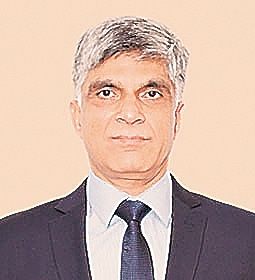After the completion of the Udhampur-Srinagar-Baramulla Rail Link (USBRL), the 125-km Rishikesh-Karnaprayag line is another ‘Himalayan project’ of the Indian Railways. On April 16, it completed a major breakthrough of a 14.57 km long tunnel, also called T-8, on the line, which is slated to be India’s longest transportation tunnel, marking the first instance of the Indian Railways successfully using Tunnel Boring Machine (TBM) for excavation in the Himalayan geology. Navratna PSU (RVNL) is tasked with implementing the Rishikesh-Karnaprayag project to ensure its timely completion. In an interview with The Indian Express, PRADEEP GAUR, chairperson and MD of RVNL tells DHEERAJ MISHRA the the Rishikesh-Karnaprayag project is of paramount significance as it is a gateway to the China border.
Edited Excerpts:
What is the importance of the Rishikesh-Karnaprayag line?
The Rishikesh-Karnaprayag Railway line is important mainly for two reasons. First, it is rail connectivity to the people in the remote areas of the hills. Out of 125 km of the project, a total of 105 km is going through the tunnels and then bridges. So, virtually except for yards, it is a completely underground train. It will provide safe travel in all weather as roads built alongside the hills are always vulnerable to landslides.
Secondly, it is a movement towards the China border. This is declared a strategically important project. So far, it is up to Karnaprayag, but it has been planned to take it beyond. All this will help to move the heavy Army machinery to the border in a camouflage condition because almost all the movement will be done under the tunnel.
The line will be extended to Joshimath, Gangotri, Yamunotri for Char Dham. We have already submitted the Final Location Survey and detailed cost to the Railway Board. The extension project is yet to be sanctioned. The Army wants to extend it to Mana, which is located at a very high level, almost 3,500 m above sea level. It will be taken as far as we can take this line.
Why did you use the Tunnel Boring Machine (TBM) in T-8?
We got this project in 2012 and after a detailed survey, we submitted the estimates to the government in 2016. From 2016 to 2019, we did a detailed investigation, completed land acquisition and forest clearance. We started working on the project in 2020.
T-8 is going to be the longest tunnel in India. Beside these two openings, there was not any possibility to have any other opening on this stretch. If we would have excavated this tunnel through the conventional method, it would have taken nine years to complete it. So, because of uniform geological conditions, we decided that we will use the Tunnel Boring Machine (TBM). Usually, people are not confident in using TBM in the Himalayas, and rightly so, because there are many cases of failure. In addition to the geology, the movement of tectonic plates also makes tunneling difficult. The geology of the Alps mountain range is similar to ours, but the movement of tectonic plates make it more challenging.
The geology of the rock in the tunnel can be understood as the average MPa (a unit of pressure commonly used to measure the compressive strength of rocks) of the rock is around 35. While the granite has more than 200 MPa. So the mountain is very fragile and as we move ahead excavating, there is always a risk of squeezing or shrinking of the opening, which can also lead to a collapse.
How did you overcome these challenges?
Look, given the geology of the area, it was obvious that we will face a number of challenges. But we anticipated all these things in advance and planned accordingly. The important thing about tunneling is what you can predict. To ensure safe and efficient excavation, one has to predict all the possible things that may occur during the work. Once you do this, you will be fully prepared.
So, we did an extensive investigation with Airborne Electromagnetic testing. Under this technique, there is a big frame which is carried by the helicopter over the alignment. The machine bombards the electromagnetic radiation, which strikes on the alignment. Using this technology, we got to know about the mountain strata.
Second, the machinery used in the tunnel is the latest state of art machinery in the world like jumbo dills, loaders, shotcrete machine, multi-service vehicles, etc.
For instance, in drill and blast, first we drill a hole and then fit it with explosives for the blast. Now the alignment of the hole is very important. If you drill the hole correctly, it will blast exactly as much as you designed. If you drill it crookedly, it will overbreak the rock. Using these latest machines, we have never had any problem with overbreaking.
Along with this, we streamline the tendering system. We took the geological risk on our head so that the contractor does not feel overburdened with the concerns of mishappening. We owned up the investigation that if anything goes wrong, RVNL will compensate the contractors. It was one of the biggest factors which gave them confidence.
How was the alignment of the line decided?
Tunneling does not mean to call a tender and ask the contractor to excavate the mountain. We should spend on “Sharpening the axe”, like other developed countries do. We did around six years of investigation and if we had not done this, we would not have been able to achieve all this. If you are making an alignment, which avoids the dangerous pitfalls, half of work is done.
From which countries were the machines procured and how were they transported to the site?
The machinery used in the tunnel was bought from two companies, Swedish company Epiroc, a Finnish company Sandvik. We bought almost 40 fully automatic machines for the tunnel. TBM was bought from the German company Herrenknecht. The important thing is that the machine was manufactured in Germany, brought to Mundra port after dismantling it and then brought to the site. We faced challenges in transportation after Rishikesh as it lies in the hilly area.
There is a small bridge spanning almost 100 m at the Ganga. We did not know the load carrying capacity. Because, without knowing the capacity, it was not possible to transport such heavy machinery. So we did a load test.
The heaviest part of the machine was 168 tonnes. That was a huge challenge. We wanted to carry it in one single piece. We could have dismantled it and transported it part by part, but we could not have achieved finishing while assembling at the site as compared to the factory finishing.
Another reason is that the most critical part of the TBM, which is called main drive, had the chances of shields being damaged. You can not drive the TBM if the shield is damaged and the replacement of these parts inside the tunnel was almost impossible. So we did not take any chances on this.
Along with this, there were chances of dust accumulation and ingression at the site during assembling the TBM, which had a very bad impact on its working and dust particles could cut the shield. So it was decided to transport it in one part.
It is a Rs 250 crore machine. Its dimension was also large, almost 6.8 m. So, in the narrow area, we had to lift it and stand it vertically using the crane. After crossing the narrow road, we again made it horizontal. It took 2.5 months for the complete assembling of the TBM.
What is the reason for using two tunneling methods?
From ordering a TBM to the commissioning, it takes almost 16 months. So in this tunnel, as it is 14.57 km long, we did not wait for the starting of the TBM and began excavation through New Austrian Tunnelling Method (NATM) from the other side. The actual TBM excavation started in March 2023. Out of the 14.57 km, 10.47 was excavated through by TBM and 4.11 km by NATM. It took 760 days to excavate 10,470 m by TBM. So the average progress was 415 m per month.
It is the world’s second fastest excavation in the category of 9-10 m tunneling. The fastest is 423 m per month in Spain’s cabrera tunnel. But they had good geology of limestone. Our geology is of phyllite rocks. Stronger the mountain, the easier it is to tunnel in it.
Kashmir Rail Link is also a similar project. Were there any learnings drawn from it for the Rishikesh-Karnaprayag Line?
Yes, the most important learning was the alignment to avoid any additional expenditure. In the Kashmir rail line, accessibility was a major issue. The alignment was deep into the area which was remote, where there was no connectivity by the road. So we had to build a road for transportation of machinery. We built approach roads of 215 km.
In this alignment, we took care of these things that let’s not make big roads and let’s have tunnel portals near the highways or where there is an accessibility. So we made only 11-12 km road in this project. Thus the additional work can be avoided.
There are big bridges like Chenab and Anji Khad in the Srinagar line. In this, we took an alignment in such a matter that we do not have to build big bridges. In this project, the bridges are a maximum of 50 m high. It saved us a lot of money, time and resources.
What is the completion target for Rishikesh-Karnaprayag line?
Our target is to start the operation of the train by December 2026. The total tunneling on the line is 213 km, which includes main tunnel, escape tunnel, out of this, 195 km is complete. All this has been done in just three years and nine months. Our aim is to complete the excavation by the end of this year.
What is the next major project of RVNL?
Our next major project is 63-km long Bhanupli (Punjab) to Bilaspur (Himachal Pradesh) line, which will further go up to Leh, Ladakh.








